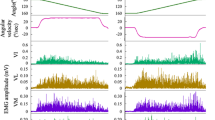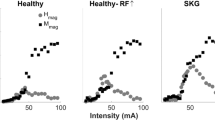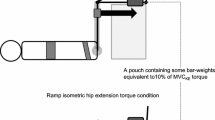Abstract
The spectral properties of surface electromyographic (EMG) signal in the rectus femoris (RF) and the coactivation in the medial hamstrings (MH) were investigated in 45 stroke subjects (22 ± 12 days post-onset) and 30 age-matched healthy controls who performed unilateral knee extensions at maximum effort (100% MVC) and during 5-s force-matching tasks (10, 30, 50% MVC). The spectral properties were obtained through a power spectrum analysis based on Fast Fourier Transform. The coactivation was measured as the MH amplitude (%max) and MH/RF amplitude ratio. Force variability was expressed as the coefficient of variation. Both knee extensors and flexors were weaker in the paretic leg than the non-paretic and control legs (p < 0.001). A significantly higher relative power in the 5–13 and 13–30 Hz bands was found in the paretic than the non-paretic leg across all force levels (p ≤ 0.001) without changes in the 30–60 and 60–100 Hz bands or the mean and median frequencies. Regarding the antagonist coactivation, MH amplitude in the paretic leg was higher than in the non-paretic leg (submaximal levels, p < 0.0001) and the control leg (all force levels, p = 0.0005) with no differences between legs in the MH/RF ratio. The steadiness of the knee extension force was not related to the spectral properties of the agonist EMG or antagonistic coactivation. Greater coactivation was associated with weaker paretic knee flexors (p ≤ 0.0002). The overall results suggest variably altered agonist activation and antagonistic coactivation over the range of isometric knee extension contractions in subacute stroke.





Similar content being viewed by others
Availability of data and materials
The data used in this study are available from the corresponding author upon reasonable request.
Code availability
Custom codes are available from the corresponding author upon reasonable request.
References
Bandholm T, Rose MH, Sløk R et al (2009) Ankle torque steadiness is related to muscle activation variability and coactivation in children with cerebral palsy. Muscle Nerve 40:402–410. https://doi.org/10.1002/mus.21348
Bartuzi P, Roman-Liu D, Tokarski T (2007) A study of the influence of muscle type and muscle force level on individual frequency bands of the EMG power spectrum. Int J Occup Saf Ergon 13:241–254. https://doi.org/10.1080/10803548.2007.11076725
Bhagchandani N, Schindler-Ivens S (2012) Reciprocal inhibition post-stroke is related to reflex excitability and movement ability. Clin Neurophysiol 123:2239–2246. https://doi.org/10.1016/j.clinph.2012.04.023
Boer P (1984) Estimated lean body mass as an index for normalization of body fluid volumes in humans. Am J Physiol Physiol 247:F632–F636. https://doi.org/10.1152/ajprenal.1984.247.4.F632
Bohannon RW, Smith MB (1987) Interrater reliability of a modified Ashworth scale of muscle spasticity. Phys Ther 67:206–207. https://doi.org/10.1093/ptj/67.2.206
Brown P (2000) Cortical drives to human muscle: the Piper and related rhythms. Prog Neurobiol 60:97–108. https://doi.org/10.1016/s0301-0082(99)00029-5
Burnett RA, Laidlaw DH, Enoka RM (2000) Coactivation of the antagonist muscle does not covary with steadiness in old adults. J Appl Physiol 89:61–71. https://doi.org/10.1152/jappl.2000.89.1.61
Chang SH, Francisco GE, Zhou P et al (2013) Spasticity, weakness, force variability, and sustained spontaneous motor unit discharges of resting spastic-paretic biceps brachii muscles in chronic stroke. Muscle Nerve 48:85–92. https://doi.org/10.1002/mus.23699
Chow JW, Stokic DS (2011) Force control of quadriceps muscle is bilaterally impaired in subacute stroke. J Appl Physiol 111:1290–1295. https://doi.org/10.1152/japplphysiol.00462.2011
Chow JW, Stokic DS (2018) Improvements in force variability and structure from vision- to memory-guided submaximal isometric knee extension in subacute stroke. J Appl Physiol 124:592–603. https://doi.org/10.1152/japplphysiol.00717.2017
Chow JW, Stokic DS (2019) Gait impairments in patients without lower limb hypertonia early poststroke are related to weakness of paretic knee flexors. Arch Phys Med Rehabil 100:1091–1101. https://doi.org/10.1016/j.apmr.2018.10.014
Chow JW, Stokic DS (2020) Relations between knee and ankle muscle coactivation and temporospatial gait measures in patients without hypertonia early after stroke. Exp Brain Res 238:2909–2919. https://doi.org/10.1007/s00221-020-05936-2
Chow JW, Yablon SA, Stokic DS (2012) Coactivation of ankle muscles during stance phase of gait in patients with lower limb hypertonia after acquired brain injury. Clin Neurophysiol 123:1599–1605. https://doi.org/10.1016/j.clinph.2012.01.006
Cohen J (1988) Statistical power analysis for the behavioural sciences, 2nd edn. Lawrence Erlbaum Associates, Hillsdale, NJ
Collen FM, Wade DT, Bradshaw CM et al (1990) Mobility after stroke: reliability of measures of impairment and disability. Int Disabil Stud 12:6–9. https://doi.org/10.3109/03790799009166594
Conway BA, Halliday DM, Farmer SF et al (1995) Synchronization between motor cortex and spinal motoneuronal pool during the performance of a maintained motor task in man. J Physiol 489:917–924. https://doi.org/10.1113/jphysiol.1995.sp021104
Cram JR, Kasman GS (1998) Introduction to surface electromyography. Aspen Publisher, Gaithersburg, MD
Dai C, Suresh NL, Suresh AK et al (2017) Altered motor unit discharge coherence in paretic muscles of stroke survivors. Front Neurol. https://doi.org/10.3389/fneur.2017.00202
Danion F, Galléa C (2004) The relation between force magnitude, force steadiness, and muscle co-contraction in the thumb during precision grip. Neurosci Lett 368:176–180. https://doi.org/10.1016/j.neulet.2004.07.006
Farina D (2008) Counterpoint: spectral properties of the surface EMG do not provide information about motor unit recruitment and muscle fiber type. J Appl Physiol 105:1673–1674. https://doi.org/10.1152/japplphysiol.90598.2008a
Farmer SF, Bremner FD, Halliday DM et al (1993) The frequency content of common synaptic inputs to motoneurones studied during voluntary isometric contraction in man. J Physiol 470:127–155. https://doi.org/10.1113/jphysiol.1993.sp019851
Fugl-Meyer AR, Jaasko L, Leyman I et al (1975) The post-stroke hemiplegic patient. 1. a method for evaluation of physical performance. Scand J Rehabil Med 7:13–31
Graves AE, Kornatz KW, Enoka RM (2000) Older adults use a unique strategy to lift inertial loads with the elbow flexor muscles. J Neurophysiol 83:2030–2039. https://doi.org/10.1152/jn.2000.83.4.2030
Hamilton LD, Mazzo MR, Petrigna L et al (2019) Poor estimates of motor variability are associated with longer grooved pegboard times for middle-aged and older adults. J Neurophysiol 121:588–601. https://doi.org/10.1152/jn.00543.2018
Hsieh CL, Hsueh IP, Mao HF (2000) Validity and responsiveness of the Rivermead Mobility Index in stroke patients. Scand J Rehabil Med 32:140–142. https://doi.org/10.1080/003655000750045497
Jakobi JM, Cafarelli E (1998) Neuromuscular drive and force production are not altered during bilateral contractions. J Appl Physiol 84:200–206. https://doi.org/10.1152/jappl.1998.84.1.200
Jensen BR, Olesen AT, Pedersen MT et al (2013) Effect of generalized joint hypermobility on knee function and muscle activation in children and adults. Muscle Nerve 48:762–769. https://doi.org/10.1002/mus.23802
Kaplanis PA, Pattichis CS, Hadjileontiadis LJ, Roberts VC (2009) Surface EMG analysis on normal subjects based on isometric voluntary contraction. J Electromyogr Kinesiol 19:157–171. https://doi.org/10.1016/j.jelekin.2007.03.010
Kennedy DM, Christou EA (2011) Greater amount of visual information exacerbates force control in older adults during constant isometric contractions. Exp Brain Res 213:351–361. https://doi.org/10.1007/s00221-011-2777-x
Kleine BU, Stegeman DF, Mund D, Anders C (2001) Influence of motoneuron firing synchronization on SEMG characteristics in dependence of electrode position. J Appl Physiol 91:1588–1599. https://doi.org/10.1152/jappl.2001.91.4.1588
Krishnan C, Allen EJ, Williams GN (2011) Effect of knee position on quadriceps muscle force steadiness and activation strategies. Muscle Nerve 43:563–573. https://doi.org/10.1002/mus.21981
Larsen LH, Zibrandtsen IC, Wienecke T et al (2017) Corticomuscular coherence in the acute and subacute phase after stroke. Clin Neurophysiol 128:2217–2226. https://doi.org/10.1016/j.clinph.2017.08.033
Li X, Shin H, Zhou P et al (2014) Power spectral analysis of surface electromyography (EMG) at matched contraction levels of the first dorsal interosseous muscle in stroke survivors. Clin Neurophysiol 125:988–994. https://doi.org/10.1016/j.clinph.2013.09.044
McAuley JH, Marsden CD (2000) Physiological and pathological tremors and rhythmic central motor control. Brain 123:1545–1567. https://doi.org/10.1093/brain/123.8.1545
Moon H, Kim C, Kwon M et al (2014) Force control is related to low-frequency oscillations in force and surface EMG. PLoS ONE 9:e109202. https://doi.org/10.1371/journal.pone.0109202
Nagai K, Yamada M, Uemura K et al (2011) Differences in muscle coactivation during postural control between healthy older and young adults. Arch Gerontol Geriatr 53:338–343. https://doi.org/10.1016/j.archger.2011.01.003
Pereira HM, Spears VC, Schlinder-Delap B et al (2015) Age and sex differences in steadiness of elbow flexor muscles with imposed cognitive demand. Eur J Appl Physiol 115:1367–1379. https://doi.org/10.1007/s00421-015-3113-0
Phinyomark A, Phukpattaranont P, Limsakul C (2012) Feature reduction and selection for EMG signal classification. Expert Syst Appl 39:7420–7431. https://doi.org/10.1016/j.eswa.2012.01.102
Pincivero D, Coelho A, Campy R et al (2002) The effects of voluntary contraction effort on quadriceps femoris electromyogram median frequency in humans: a muscle and sex comparison. Eur J Appl Physiol 87:448–455. https://doi.org/10.1007/s00421-002-0658-5
Prodoehl J, Vaillancourt DE (2010) Effects of visual gain on force control at the elbow and ankle. Exp Brain Res 200:67–79. https://doi.org/10.1007/s00221-009-1966-3
Reeves NP, Cholewicki J, Milner T, Lee AS (2008) Trunk antagonist co-activation is associated with impaired neuromuscular performance. Exp Brain Res 188:457–463. https://doi.org/10.1007/s00221-008-1378-9
Robichaud JA, Pfann KD, Vaillancourt DE et al (2005) Force control and disease severity in Parkinson’s disease. Mov Disord 20:441–450. https://doi.org/10.1002/mds.20350
Rosa MCN, Marques A, Demain S, Metcalf CD (2014) Lower limb co-contraction during walking in subjects with stroke: A systematic review. J Electromyogr Kinesiol 24:1–10. https://doi.org/10.1016/j.jelekin.2013.10.016
Rose MH, Løkkegaard A, Sonne-Holm S, Jensen BR (2013) Tremor irregularity, torque steadiness and rate of force development in Parkinson’s disease. Mot Control 17:203–216
Salenius S, Portin K, Kajola M et al (1997) Cortical control of human motoneuron firing during isometric contraction. J Neurophysiol 77:3401–3405. https://doi.org/10.1152/jn.1997.77.6.3401
Salomoni SE, Graven-Nielsen T (2012) Experimental muscle pain increases normalized variability of multidirectional forces during isometric contractions. Eur J Appl Physiol 112:3607–3617. https://doi.org/10.1007/s00421-012-2343-7
Simon ES (1996) Changes in spinal recurrent inhibition in patients during the immediate post-stroke period. J Neuro Rehab 10:35–42
Smith AM (1981) The coactivation of antagonist muscles. Can J Physiol Pharmacol 59:733–747. https://doi.org/10.1139/y81-110
Tang A, Rymer WZ (1981) Abnormal force EMG relations in paretic limbs of hemiparetic human subjects. J Neurol Neurosurg Psychiatry 44:690–698. https://doi.org/10.1136/jnnp.44.8.690
Tang SF, Hong J-P, McKay WB et al (2012) Modification of altered ankle motor control after stroke using focal application of botulinum toxin type A. Clin Neurol Neurosurg 114:498–501. https://doi.org/10.1016/j.clineuro.2012.03.014
Tracy BL, Enoka RM (2002) Older adults are less steady during submaximal isometric contractions with the knee extensor muscles. J Appl Physiol 92:1004–1012. https://doi.org/10.1152/japplphysiol.00954.2001
Ushiyama J, Takahashi Y, Ushiba J (2010) Muscle dependency of corticomuscular coherence in upper and lower limb muscles and training-related alterations in ballet dancers and weightlifters. J Appl Physiol 109:1086–1095. https://doi.org/10.1152/japplphysiol.00869.2009
Vila-Chã C, Hassanlouei H, Farina D, Falla D (2012) Eccentric exercise and delayed onset muscle soreness of the quadriceps induce adjustments in agonist-antagonist activity, which are dependent on the motor task. Exp Brain Res 216:385–395. https://doi.org/10.1007/s00221-011-2942-2
von Tscharner V, Nigg BM (2008) Point:Counterpoint: Spectral properties of the surface EMG can characterize/do not provide information about motor unit recruitment strategies and muscle fiber type. J Appl Physiol 105:1671–1673. https://doi.org/10.1152/japplphysiol.90598.2008
Wagner JM, Dromerick AW, Sahrmann SA, Lang CE (2007) Upper extremity muscle activation during recovery of reaching in subjects with post-stroke hemiparesis. Clin Neurophysiol 118:164–176. https://doi.org/10.1016/j.clinph.2006.09.022
Wang LJ, Yu XM, Shao QN et al (2020) Muscle fatigue enhance beta band EMG-EMG coupling of antagonistic muscles in patients with post-stroke spasticity. Front Bioeng Biotechnol 8:1007. https://doi.org/10.3389/fbioe.2020.01007
Wu R, Delahunt E, Ditroilo M et al (2019) Torque steadiness and neuromuscular responses following fatiguing concentric exercise of the knee extensor and flexor muscles in young and older individuals. Exp Gerontol 124:110636. https://doi.org/10.1016/j.exger.2019.110636
Yao W, Fuglevand RJ, Enoka RM (2000) Motor-unit synchronization increases EMG amplitude and decreases force steadiness of simulated contractions. J Neurophysiol 83:441–452. https://doi.org/10.1152/jn.2000.83.1.441
Yao B, Zhang X, Li S et al (2015) Analysis of linear electrode array EMG for assessment of hemiparetic biceps brachii muscles. Front Hum Neurosci 9:569. https://doi.org/10.3389/fnhum.2015.00569
Yuan H, Ge P, Du L, Xia Q (2019) Co-contraction of lower limb muscles contributes to knee stability during stance phase in hemiplegic stroke patients. Med Sci Monit 25:7443–7450. https://doi.org/10.12659/MSM.916154
Acknowledgements
This work was supported in part by the Wilson Research Foundation and H.F. McCarty, Jr. Family Foundation Fund for Stroke Research (Jackson, MS, USA). We are grateful to Jennifer Sivak, L. Anthony Smith, and M. Dawn Norman for their assistance with this study. Dr. Chow is the Gertrude C. Ford Director of Motion Analysis.
Funding
Wilson Research Foundation (Jackson, MS, USA), H.F. McCarty, Jr. Family Foundation Fund for Stroke Research (Jackson, MS, USA), and Gertrude C. Ford Foundation (Ridgeland, MS, USA).
Author information
Authors and Affiliations
Contributions
Both authors contributed to the conception of research, experimental design, data collection and analysis, and preparation of manuscript.
Corresponding author
Ethics declarations
Conflict of interest
The authors declare that they have no conflict of interest.
Ethics approval
This study was approved by the Institutional Review Board of Methodist Rehabilitation Center. The procedures used in this study adhere to the tenets of the Declaration of Helsinki.
Consent to participate
Informed consent was obtained from all individual participants included in the study.
Consent to publish
The consent to publish was included in the informed consent signed by all participants.
Additional information
Communicated by Francesco Lacquaniti.
Publisher's Note
Springer Nature remains neutral with regard to jurisdictional claims in published maps and institutional affiliations.
Rights and permissions
About this article
Cite this article
Chow, J.W., Stokic, D.S. Characteristics of rectus femoris activation and rectus femoris–hamstrings coactivation during force-matching isometric knee extension in subacute stroke. Exp Brain Res 239, 2621–2633 (2021). https://doi.org/10.1007/s00221-021-06162-0
Received:
Accepted:
Published:
Issue Date:
DOI: https://doi.org/10.1007/s00221-021-06162-0




